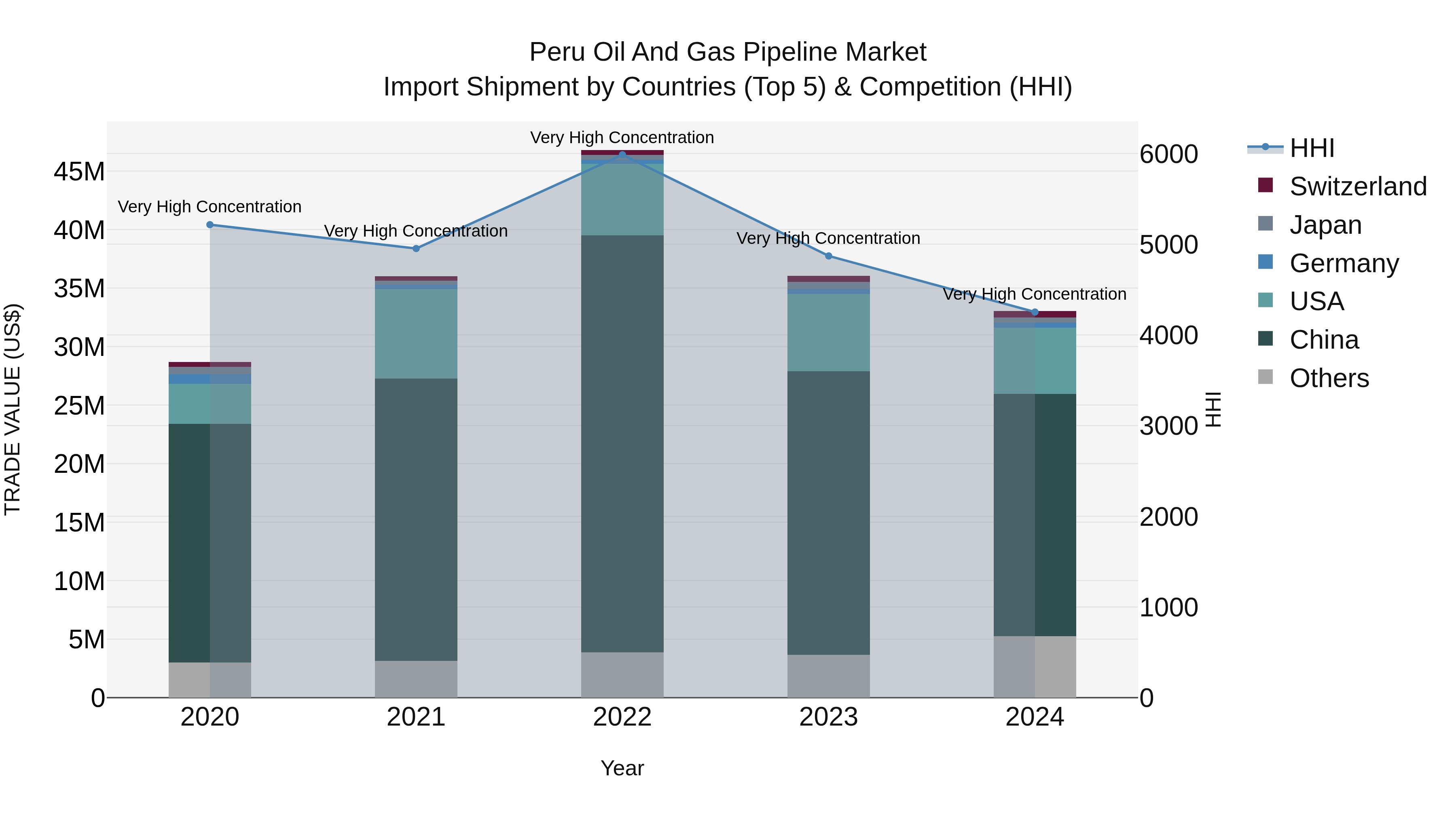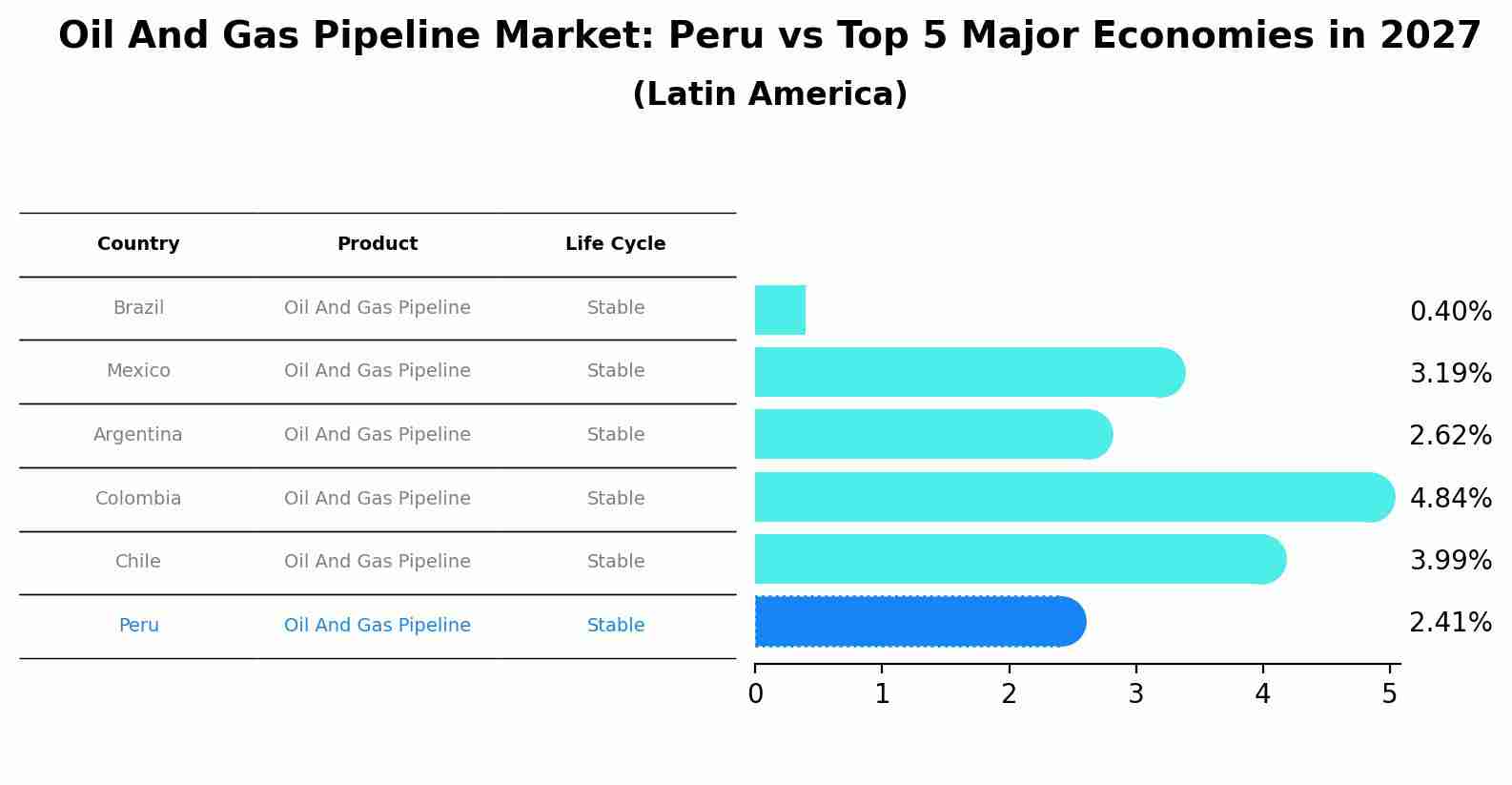Peru Oil And Gas Pipeline Market Outlook | Industry, Value, Size, Analysis, Share, Trends, COVID-19 IMPACT, Companies, Revenue, Growth & Forecast
| Product Code: ETC377286 | Publication Date: Aug 2022 | Updated Date: Nov 2025 | Product Type: Market Research Report | |
| Publisher: 6Wresearch | Author: Sumit Sagar | No. of Pages: 75 | No. of Figures: 35 | No. of Tables: 20 |
Peru Oil And Gas Pipeline Market Top 5 Importing Countries and Market Competition (HHI) Analysis
In 2024, Peru continued to heavily rely on oil and gas pipeline imports, with top exporting countries being China, USA, Mexico, Hong Kong, and Chile. The high Herfindahl-Hirschman Index (HHI) indicates a concentrated market. Despite a modest compound annual growth rate (CAGR) of 3.58% from 2020 to 2024, there was a notable decline in growth rate from 2023 to 2024, showing a challenging year for the industry. The market dynamics suggest a need for strategic planning to navigate uncertainties and sustain growth in the coming years.

Oil And Gas Pipeline Market: Peru vs Top 5 Major Economies in 2027 (Latin America)
The Oil And Gas Pipeline market in Peru is projected to grow at a stable growth rate of 2.41% by 2027, highlighting the country's increasing focus on advanced technologies within the Latin America region, where Brazil holds the dominant position, followed closely by Mexico, Argentina, Colombia and Chile, shaping overall regional demand.

Peru Oil And Gas Pipeline Market Synopsis
The Peru Oil and Gas Pipeline Market is characterized by a growing demand for energy infrastructure to support the country`s oil and gas industry. The market is driven by increasing investments in pipeline construction projects to transport crude oil and natural gas from production sites to refineries and distribution centers. Key players in the market are focusing on the expansion of pipeline networks to enhance connectivity and ensure efficient transportation of energy resources. Government initiatives promoting the development of pipeline infrastructure, along with favorable regulatory policies, are further propelling the market growth. Additionally, the adoption of advanced technologies in pipeline construction and maintenance activities is expected to drive innovation and efficiency in the Peru Oil and Gas Pipeline Market.
Peru Oil And Gas Pipeline Market Trends
The Peru Oil and Gas Pipeline Market is experiencing several key trends. One significant trend is the increasing investment in pipeline infrastructure to support the growing demand for natural gas and oil transportation within the country. Additionally, there is a focus on the development of more efficient and environmentally friendly pipeline technologies to improve operational efficiency and reduce environmental impact. Another trend is the expansion of pipeline networks to reach remote and underserved areas, ensuring broader access to energy resources. Furthermore, there is a growing emphasis on collaboration between industry players and government entities to enhance regulatory frameworks and facilitate the expansion of pipeline projects efficiently. Overall, these trends reflect a dynamic and evolving landscape in the Peru Oil and Gas Pipeline Market.
Peru Oil And Gas Pipeline Market Challenges
In the Peru Oil and Gas Pipeline Market, some of the key challenges faced include regulatory hurdles and permitting delays, environmental concerns, land acquisition issues, and potential opposition from local communities. The complex regulatory environment in Peru can often lead to delays in project approvals and implementation, impacting the overall development timeline and increasing project costs. Additionally, environmental regulations and the need to navigate sensitive ecosystems can pose challenges for pipeline construction. Land acquisition can also be a major obstacle, as securing rights-of-way in a diverse landscape can be time-consuming and costly. Moreover, resistance from local communities due to concerns over environmental impact, land rights, and potential disruptions to their livelihoods can further complicate pipeline projects in Peru. Addressing these challenges requires collaboration with stakeholders, robust risk management strategies, and effective community engagement practices.
Peru Oil And Gas Pipeline Market Investment Opportunities
The Peru Oil and Gas Pipeline Market offers promising investment opportunities due to the country`s growing energy demand and increasing focus on enhancing its oil and gas infrastructure. With significant reserves of oil and gas, there is a need for expanding and modernizing the pipeline network to efficiently transport these resources. Investors can consider opportunities in pipeline construction, maintenance, and operation services to capitalize on the expanding market. Additionally, the Peruvian government`s initiatives to attract foreign investment in the energy sector further enhance the potential for profitable investments in the oil and gas pipeline market in Peru. Overall, investing in the Peru Oil and Gas Pipeline Market can provide long-term growth prospects and contribute to the country`s energy security goals.
Jordan Agar Market Government Policies
In Peru, government policies related to the oil and gas pipeline market focus on promoting investment and sustainable development in the sector. The government encourages private participation through a regulatory framework that ensures transparency and fair competition. Additionally, there are regulations in place to protect the environment and ensure the safe operation of pipelines, including requirements for environmental impact assessments and emergency response plans. The government also prioritizes the expansion and modernization of pipeline infrastructure to support the growing energy needs of the country and promote regional integration. Overall, Peru`s policies aim to attract investment, promote responsible resource development, and ensure the efficient and reliable transportation of oil and gas through pipelines.
Peru Oil And Gas Pipeline Market Future Outlook
The future outlook for the Peru Oil and Gas Pipeline Market appears promising with anticipated growth driven by several factors. The market is likely to benefit from increasing investments in the oil and gas sector, as well as the government`s initiatives to enhance infrastructure development. Additionally, the discovery of new oil and gas reserves in the region is expected to further boost the demand for pipeline infrastructure. The growing focus on energy security and the need for efficient transportation of oil and gas resources are also key drivers for market expansion. However, challenges such as regulatory hurdles and environmental concerns may pose some constraints. Overall, the Peru Oil and Gas Pipeline Market is projected to witness steady growth in the coming years, presenting opportunities for industry players to capitalize on the evolving market dynamics.
Key Highlights of the Report:
- Peru Oil And Gas Pipeline Market Outlook
- Market Size of Peru Oil And Gas Pipeline Market, 2021
- Forecast of Peru Oil And Gas Pipeline Market, 2031
- Historical Data and Forecast of Peru Oil And Gas Pipeline Revenues & Volume for the Period 2018 - 2031
- Peru Oil And Gas Pipeline Market Trend Evolution
- Peru Oil And Gas Pipeline Market Drivers and Challenges
- Peru Oil And Gas Pipeline Price Trends
- Peru Oil And Gas Pipeline Porter's Five Forces
- Peru Oil And Gas Pipeline Industry Life Cycle
- Historical Data and Forecast of Peru Oil And Gas Pipeline Market Revenues & Volume By Location of Deployment for the Period 2018 - 2031
- Historical Data and Forecast of Peru Oil And Gas Pipeline Market Revenues & Volume By Onshore for the Period 2018 - 2031
- Historical Data and Forecast of Peru Oil And Gas Pipeline Market Revenues & Volume By Offshore for the Period 2018 - 2031
- Historical Data and Forecast of Peru Oil And Gas Pipeline Market Revenues & Volume By Type for the Period 2018 - 2031
- Historical Data and Forecast of Peru Oil And Gas Pipeline Market Revenues & Volume By Crude Oil Pipeline for the Period 2018 - 2031
- Historical Data and Forecast of Peru Oil And Gas Pipeline Market Revenues & Volume By Gas Pipeline for the Period 2018 - 2031
- Peru Oil And Gas Pipeline Import Export Trade Statistics
- Market Opportunity Assessment By Location of Deployment
- Market Opportunity Assessment By Type
- Peru Oil And Gas Pipeline Top Companies Market Share
- Peru Oil And Gas Pipeline Competitive Benchmarking By Technical and Operational Parameters
- Peru Oil And Gas Pipeline Company Profiles
- Peru Oil And Gas Pipeline Key Strategic Recommendations
Frequently Asked Questions About the Market Study (FAQs):
- Single User License$ 1,995
- Department License$ 2,400
- Site License$ 3,120
- Global License$ 3,795
Search
Thought Leadership and Analyst Meet
Our Clients
Related Reports
- Canada Oil and Gas Market (2026-2032) | Share, Segmentation, Value, Industry, Trends, Forecast, Analysis, Size & Revenue, Growth, Competitive Landscape, Outlook, Companies
- Germany Breakfast Food Market (2026-2032) | Industry, Share, Growth, Size, Companies, Value, Analysis, Revenue, Trends, Forecast & Outlook
- Australia Briquette Market (2025-2031) | Growth, Size, Revenue, Forecast, Analysis, Trends, Value, Share, Industry & Companies
- Vietnam System Integrator Market (2025-2031) | Size, Companies, Analysis, Industry, Value, Forecast, Growth, Trends, Revenue & Share
- ASEAN and Thailand Brain Health Supplements Market (2025-2031) | Strategy, Consumer Insights, Analysis, Investment Trends, Opportunities, Growth, Size, Share, Industry, Revenue, Segments, Value, Segmentation, Supply, Forecast, Restraints, Outlook, Competition, Drivers, Trends, Demand, Pricing Analysis, Competitive, Strategic Insights, Companies, Challenges
- ASEAN Bearings Market (2025-2031) | Strategy, Consumer Insights, Analysis, Investment Trends, Opportunities, Growth, Size, Share, Industry, Revenue, Segments, Value, Segmentation, Supply, Forecast, Restraints, Outlook, Competition, Drivers, Trends, Demand, Pricing Analysis, Competitive, Strategic Insights, Companies, Challenges
- Europe Flooring Market (2025-2031) | Outlook, Share, Industry, Trends, Forecast, Companies, Revenue, Size, Analysis, Growth & Value
- Saudi Arabia Manlift Market (2025-2031) | Outlook, Size, Growth, Trends, Companies, Industry, Revenue, Value, Share, Forecast & Analysis
- Uganda Excavator, Crane, and Wheel Loaders Market (2025-2031) | Strategy, Consumer Insights, Analysis, Investment Trends, Opportunities, Growth, Size, Share, Industry, Revenue, Segments, Value, Segmentation, Supply, Forecast, Restraints, Outlook, Competition, Drivers, Trends, Demand, Pricing Analysis, Competitive, Strategic Insights, Companies, Challenges
- Rwanda Excavator, Crane, and Wheel Loaders Market (2025-2031) | Strategy, Consumer Insights, Analysis, Investment Trends, Opportunities, Growth, Size, Share, Industry, Revenue, Segments, Value, Segmentation, Supply, Forecast, Restraints, Outlook, Competition, Drivers, Trends, Demand, Pricing Analysis, Competitive, Strategic Insights, Companies, Challenges
Industry Events and Analyst Meet
Whitepaper
- Middle East & Africa Commercial Security Market Click here to view more.
- Middle East & Africa Fire Safety Systems & Equipment Market Click here to view more.
- GCC Drone Market Click here to view more.
- Middle East Lighting Fixture Market Click here to view more.
- GCC Physical & Perimeter Security Market Click here to view more.
6WResearch In News
- Doha a strategic location for EV manufacturing hub: IPA Qatar
- Demand for luxury TVs surging in the GCC, says Samsung
- Empowering Growth: The Thriving Journey of Bangladesh’s Cable Industry
- Demand for luxury TVs surging in the GCC, says Samsung
- Video call with a traditional healer? Once unthinkable, it’s now common in South Africa
- Intelligent Buildings To Smooth GCC’s Path To Net Zero


















